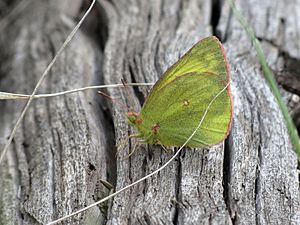Christina sulphur facts for kids
Quick facts for kids Christina sulphur |
|
|---|---|
 |
|
| Scientific classification | |
| Synonyms | |
|
Eurymus christina Lyman, 1884 |
The Christina sulphur (scientific name: Colias christina) is a beautiful butterfly that lives in western North America. It belongs to the Pieridae family, which includes many white and yellow butterflies. You can find this special butterfly flying from the Yukon and Northwest Territories in Canada, south through British Columbia, Alberta, and Saskatchewan. It also lives in parts of the United States like Wyoming, Montana, and Utah. This butterfly was named after Christina Ross, who was the first person to collect it.
What Does the Christina Sulphur Look Like?
The Christina sulphur butterfly has a unique look. Its wings are often a light orange-red color. The part of both wings closest to its body is a bright yellow. If you look at the underside of its wings, you won't see many patterns, just a small spot in the middle.
Female Christina sulphur butterflies are usually almost white. Their front wings might have a little dark dusting near the edges. They also have a black spot in the middle of their front wing, which has a white center. These butterflies can have a wingspan from about 35 to 52 millimeters. That's about the length of two to three quarters lined up!
Life of the Christina Sulphur
The Christina sulphur butterfly is active for several months of the year. You can usually see them flying around from May all the way until September.
When they are young, these butterflies are called larvae (which are like caterpillars). These larvae enjoy eating plants like Trifolium and Hedysarum species.
Different Types of Christina Sulphur Butterflies
Sometimes, within a single species, there can be slightly different groups called subspecies. These groups might look a little different or live in specific areas. Here are some known subspecies of the Christina sulphur:
- C. c. astraea Edwards, 1872 (found in Montana, Wyoming, and Utah)
- C. c. christina (found in Montana, Washington, British Columbia, Alberta, Manitoba, and the Northwest Territories)

